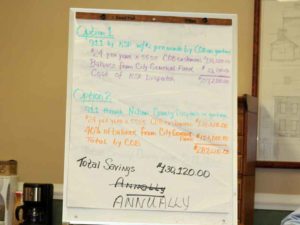Green: Dispatch board put EMS needs ahead of law enforcement

Larry Green, the city’s human resources director, points to figures on a flip chart during Monday nights safety committee discussion comparing the costs of having the Kentucky State Police dispatch city police and fire versus helping fund the joint city-county dispatch center.
By JIM BROOKS
Nelson County Gazette / WBRT Radio
Tuesday, May 24, 2016, 1 p.m. — In a presentation to the Bardstown City Council’s safety committee Monday evening, Larry Green, the city’s human resources director, accused the E-911 Dispatch board of placing the needs of the county-owned EMS service over the needs of law enforcement agencies in the board’s selection of its computer-aided dispatch software vendor.
Green’s presentation compared the costs of dispatching services through a recent Kentucky State Police proposal and with recent figures discussed at a meeting last week between Mayor John Royalty and Judge Executive Dean Watts.
KSP uses computer-aided dispatch (CAD) software from a vendor called InterAct, Green explained. InterAct is one of the nation’s top CAD software vendors, and was the local dispatch board’s top choice as well — until the board placed the needs of the county-owned EMS service ahead of law enforcement, Green said.
Green read from a letter from Dispatch Director Debbie Carter that canceled the board’s contract with InterAct last year and sought a refund of grant money the company was paid.
While the letter mentions the issue of scheduled EMS runs, the dispatch board had in fact worked with InterAct for months on a number of additional issues related to delays in the delivery of the company’s cloud-based CAD software.
After InterAct was unable to deliver on its promised software, the local dispatch board canceled its agreement and chose Zuercher, another CAD software vendor. The new Zuercher CAD system is set to go live on Thursday, May 26, and will be part of the dispatch center’s audit to certify it is E-911 Phase II compliant.

Safety Committee Chairman Bill Buckman talks with Mayor John Royalty prior to the start of Monday’s committee meeting.
WHY CAD MATTERS. For years the dispatch center has used computer-aided dispatch software from Spillman Technologies. However, Spillman’s CAD would not offer the precise addressing capability needed for 911 dispatching, Carter said, prompting the board to look for a replacement CAD.
Spillman’s CAD could only offer address ranges for the location of incoming 911 phone calls, and the dispatch board wanted a CAD that offered more exact addresses.
Carter confirmed InterAct was the board’s first choice, but after many months of waiting to get InterAct’s promised CAD, the board canceled the contract. In Dec. 2015, the board chose Zuercher as the dispatch center’s new CAD vendor.
INTERACT INDY ISSUES. At the same time last year that the county dispatch board was working with InterAct and its promised cloud-based CAD system, the City of Indianapolis was having InterAct issues of its own.
After years of missed deadlines, last December Indianapolis canceled its $12.6 million 10-year contract with InterAct for a new CAD system.
According to a story in the Indianopolis Star, InterAct never lived up to its promises; the company completed a version of its records management software in June 2014, but was unable to complete the computer-aided dispatch software. InterAct requested an extension and it was granted.
“(InterAct was) having a great deal of difficulty delivering that to us,” David Wantz, the interim director of public safety told the Star in December. “They were having trouble making payroll. They were vulnerable to going out of business … so in order to help them get purchased, we entered into another agreement.”
Despite the extension, InerAct failed to meet the December deadline, and Wantz decided to terminate the contract. In January he was set to begin work to recover some of the $8-10 million in taxpayer money paid on InterAct’s contract.
After the safety committee meeting, Carter noted that the Kentucky State Police uses an older version of InterAct’s CAD software that the vendor supports, but no longer sells or installs.
“If KSP is going to a cloud-based 911 system, they will be using another system other than InterAct,” Carter said. “It’s just not ready yet.”
DISPATCH FINANCES. Green’s presentation underscored the points he made at the April 25, 2016, safety committee meeting about the potential savings possible if the city contracts with the Kentucky State Police to dispatch city police and fire.
KSP’s quote for dispatch services stands at an annual fee of $157,200, he explained. That fee does not include the one-time costs for the equipment necessary to allow KSP to handle the dispatching services.
Using figures obtained from Judge Executive Dean Watts’ dispatch meeting last week with Mayor John Royalty, Green said the county’s proposal to move the county’s 911 fee from landlines to garbage bills would raise $130,320 from city garbage customers to help pay for 911 dispatching.
Even with the 911 fee on garbage bills, the city and county will still need to contribute additional financial support to 911. Currently the city pays 40 percent of the 911 budget shortfall, while the county government pays the rest.
While the city’s expected share of additional support is $154,000 — which is less than the KSP dispatch quote — Green said the proposal is still unfair to city taxpayers because they would be required to pay more than county residents.
City residents pay taxes to both city and county government, and therefore, they help fund the dispatch center’s budget that the 911 fees do not cover.
If the city uses KSP and also added a $2 911 fee to all city garbage customers bills, that fee alone would nearly cover the entire cost of KSP dispatching and leave a shortfall of just $23,880, Green explained.
To cover the dispatching needs of the city fire and police, KSP will add two full-time dispatchers, Green said. The proposed two-year contract would have no year-over-year price increase.
ONE-TIME EXPENDITURES FOR KSP DISPATCH. In order to have KSP dispatch for the city, the council will need to approve nearly $70,000 in one-time expenditures so KSP can remotely dispatch from the its Elizabethtown KSP Post.
The city will need to add a repeater to the antenna tower at Bardstown City Hall for $18,000; $3,680 for radio equipment at the KSP Post; $20,000 for the T-1 line and required interfaces; $14,000 for the GIS mapping upgrades; and $13,000 for the needed licenses for the the 12 city police mobile data terminals to use the KSP’s CAD and record management system.
CHAIRMAN CRITICAL OF DISPATCH. Safety committee chairman Bill Buckman was critical of the dispatch board for failing to include law enforcement needs in its selection of Zuercher as the new dispatch software vendor — a claim Carter said was not supported by the facts.
The dispatch board has two city representatives as members who participated in meetings and discusses about the need for a new CAD system going back to 2012, she said. She said queries to the city about law enforcement needs with the new CAD vendor went unanswered — mostly because she believes the city was already considering KSP for dispatching services.
“The city’s notorious for making numbers speak they way they want them to,” she said.
Councilman Francis Lydian again stated his preference for the city to remain part of the joint city-council dispatch effort. He told Green that his presentation about dispatch costs had so many different numbers he found it confusing.
Lydian told the committee that the county government had worked to help the city in the past, specifically mentioning the county-owned building that houses the city police department. He suggested the council budget include sufficient funds to allow the city to continue talks with county government over the unified dispatch center. The agreement governing the dispatch center expires in September, but that gives more time to come up with a workable agreement, Lydian said.
The committee made no recommendation in regard to 911 dispatch options.
-30-







